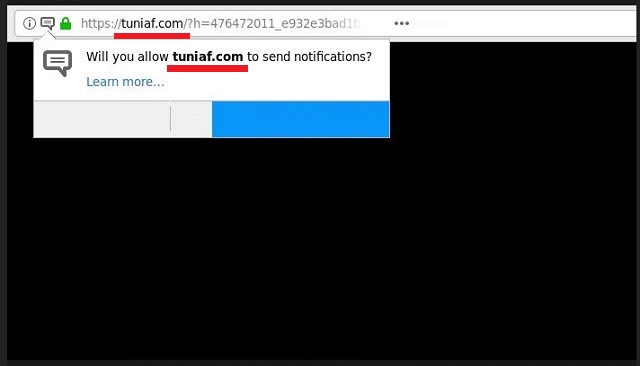Does the Tuniaf.com website appear on a daily basis? The presence of this page is a bad sign. A sign that your browser has been infected by a nasty adware-related parasite. Adware is designed to create revenue for the hackers behind it, as well as for the sponsored pages it will promote. This happens through generating multiple intrusive adverts in different forms like pop-ups, in-text, banners and blinking messages.
The more ads it displays on its victim’s screen, the better the chance of them getting clicked. In order to be even more certain that the advertisements will be as attractive as possible to the user, the malicious parasite will steal their web data such as but not limited to browsing history, habits and search queries. This information will help the adware in its task to provide targeted ad content that the user will be more likely to click on. And that’s not all that adware is capable of. It can also install questionable extensions, add-ons, toolbars and other apps on your browsers, without your knowledge and consent.
Adware is most commonly spread through spam email messages, email attachments and executable files, fake update requests, software bundles, torrent files and infected links and ads. This malicious parasite relies on your negligence, so it can slip on your computer and wreak havoc. That’s right. Adware cannot hack its way on your cyber machine alone. It needs your permission to do so. And that can happen easier than you think.

Users often don’t pay close attention to what they click on while on the web. That’s the kind of behavior that hackers rely on. Be smarter. Be extra cautious when you are browsing the internet. Steer clear of any suspiciously looking ads and links. Update your software only via official and licensed sources, do not just blindly trust the first pop-up that appears on your screen, urging you to follow a dubious update link.
We also advise you to select a custom setup mode when installing software, so no additional software can get past you without your knowledge. If you see any optional installations, it is always better to opt out of them all, since they most likely are malicious software in disguise.
Adware is oftentimes underestimated. After all, what damage could advertisements do? Well, you’d be surprised. But it’s best if you don’t find out the true capabilities of such nasty parasite. The more you prolong its stay, the worse the consequences will get. You’ll start experiencing a significant drop in your internet speed and overall performance of your browser. The former will get so overloaded with promoted content, that it won’t be able to run normally, resulting in its frequent crashes and freezes. At some point, it might even stop working altogether.
By keeping this adware on your computer you put your online privacy in jeopardy. Secure your personal and financial information, before it falls into the hands of cyber crooks that want to steal this data and sell it to other questionable third-parties. Return your browser into its normal secure and ad-free state! Act against this Tuniaf.com adware before it is too late! If you need guidance, our detailed instructions below will help you to successfully remove this annoying pest from your PC!
Tuniaf.com Removal
 Before starting the real removal process, you must reboot in Safe Mode. If you know how to do this, skip the instructions below and proceed to Step 2. If you do not know how to do it, here is how to reboot in Safe mode:
Before starting the real removal process, you must reboot in Safe Mode. If you know how to do this, skip the instructions below and proceed to Step 2. If you do not know how to do it, here is how to reboot in Safe mode:
For Windows 98, XP, Millenium and 7:
Reboot your computer. When the first screen of information appears, start repeatedly pressing F8 key. Then choose Safe Mode With Networking from the options.

For Windows 8/8.1
Click the Start button, next click Control Panel —> System and Security —> Administrative Tools —> System Configuration.

Check the Safe Boot option and click OK. Click Restart when asked.
For Windows 10
Open the Start menu and click or tap on the Power button.

While keeping the Shift key pressed, click or tap on Restart.

 Please, follow the steps precisely to remove Tuniaf.com from the browser:
Please, follow the steps precisely to remove Tuniaf.com from the browser:
Remove From Mozilla Firefox:
Open Firefox, click on top-right corner ![]() , click Add-ons, hit Extensions next.
, click Add-ons, hit Extensions next.

Look for suspicious or unknown extensions, remove them all.
Remove From Chrome:
Open Chrome, click chrome menu icon at the top-right corner —>More Tools —> Extensions. There, identify the malware and select chrome-trash-icon(Remove).

Remove From Internet Explorer:
Open IE, then click IE gear icon on the top-right corner —> Manage Add-ons.

Find the malicious add-on. Remove it by pressing Disable.

Right click on the browser’s shortcut, then click Properties. Remove everything after the .exe” in the Target box.


Open Control Panel by holding the Win Key and R together. Write appwiz.cpl in the field, then click OK.

Here, find any program you had no intention to install and uninstall it.

Run the Task Manager by right clicking on the Taskbar and choosing Start Task Manager.

Look carefully at the file names and descriptions of the running processes. If you find any suspicious one, search on Google for its name, or contact me directly to identify it. If you find a malware process, right-click on it and choose End task.

Open MS Config by holding the Win Key and R together. Type msconfig and hit Enter.

Go to the Startup tab and Uncheck entries that have “Unknown” as Manufacturer.
Still cannot remove Tuniaf.com from your browser? Please, leave a comment below, describing what steps you performed. I will answer promptly.

